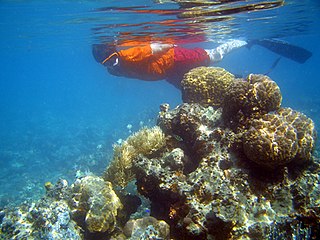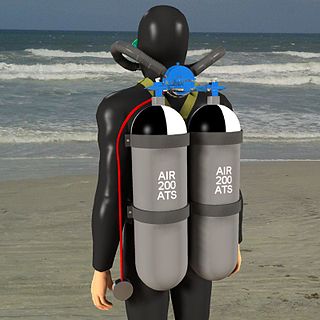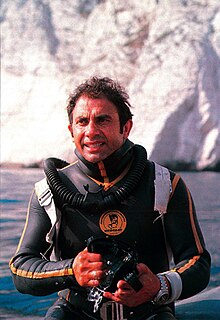The timeline of underwater diving technology is a chronological list of notable events in the history of the development of underwater diving equipment. With the partial exception of breath-hold diving, the development of underwater diving capacity, scope, and popularity, has been closely linked to available technology, and the physiological constraints of the underwater environment.

Snorkeling is the practice of swimming face down on or through a body of water while breathing the ambient air through a shaped tube called a snorkel, usually with swimming goggles or a diving mask, and swimfins. In cooler waters, a wetsuit may also be worn. The snorkel may be an independent item or integrated with the mask. The use of this equipment allows the snorkeler to observe the underwater environment for extended periods with relatively little effort, and to breathe while face-down at the surface.

Aqua-Lung was the first open-circuit, self-contained underwater breathing apparatus to achieve worldwide popularity and commercial success. This class of equipment is now commonly referred to as a twin-hose diving regulator, or demand valve. The Aqua-Lung was invented in France during the winter of 1942–1943 by two Frenchmen: engineer Émile Gagnan and Jacques Cousteau, who was a Naval Lieutenant. It allowed Cousteau and Gagnan to film and explore underwater more easily.

A wetsuit is a garment worn to provide thermal protection while wet. It is usually made of foamed neoprene, and is worn by surfers, divers, windsurfers, canoeists, and others engaged in water sports and other activities in or on water. Its purpose is to provide thermal insulation and protection from abrasion, ultraviolet exposure, and stings from marine organisms. It also contributes extra buoyancy. The insulation properties of neoprene foam depend mainly on bubbles of gas enclosed within the material, which reduce its ability to conduct heat. The bubbles also give the wetsuit a low density, providing buoyancy in water.

Freediving, free-diving, free diving, breath-hold diving, or skin diving, is a mode of underwater diving that relies on breath-holding until resurfacing rather than the use of breathing apparatus such as scuba gear.

Spearfishing is fishing using handheld elongated, sharp-pointed tools such as a spear, gig, or harpoon, to impaling the fish in the body. It was one of the earliest fishing techniques used by mankind, and has been deployed in artisanal fishing throughout the world for millennia. Early civilizations were familiar with the custom of spearing fish from rivers and streams using sharpened sticks.

Swimfins, swim fins, diving fins, or flippers are finlike accessories worn on the feet, legs or hands and made from rubber, plastic, carbon fiber or combinations of these materials, to aid movement through the water in water sports activities such as swimming, bodyboarding, bodysurfing, float-tube fishing, kneeboarding, riverboarding, scuba diving, snorkeling, spearfishing, underwater hockey, underwater rugby and various other types of underwater diving.

A speargun is a ranged underwater fishing device designed to launch a tethered spear or harpoon to impale fish or other marine animals and targets. Spearguns are used in sport fishing and underwater target shooting. The two basic types are pneumatic and elastic. Spear types come in a number of varieties including threaded, break-away and lined. Floats and buoys are common accessories when targeting larger fish.

Diving activities are the things people do while diving underwater. People may dive for various reasons, both personal and professional. While a newly qualified recreational diver may dive purely for the experience of diving, most divers have some additional reason for being underwater. Recreational diving is purely for enjoyment and has several specialisations and technical disciplines to provide more scope for varied activities for which specialist training can be offered, such as cave diving, wreck diving, ice diving and deep diving. Several underwater sports are available for exercise and competition.
Submarine Products Ltd (1959−1990) was a diving gear manufacturer, with a factory in Hexham in Northumberland, England. It was founded in 1959 by Lieutenant-Commander Hugh Oswell.

Cressi is one of the largest manufacturers of water sports equipment in the world serving the scuba dive, snorkel and swim industries. The company's five divisions cover four markets—scuba diving, snorkeling, spearfishing, and swimming. Cressi maintains a significant presence in each major economic region around the globe and delivers some 300 distinct products to more than 90 countries. Formerly Cressi-Sub, the Italian company was founded by two brothers, Egidio and Nanni Cressi in 1946 in Genoa, Italy. Still family owned and operated, the company is headed today by Antonio Cressi and its headquarters and manufacturing facilities remain in Genoa.
Johnson Outdoors Inc. produces outdoor recreational products such as watercraft, diving equipment, camping gear, and outdoor clothing. It has operations in 24 locations worldwide, employs 1,400 people and reports sales of more than $315 million. Helen Johnson-Leipold, one of Samuel Curtis Johnson, Jr.'s four children, has run the company since 1999.

A snorkel is a device used for breathing atmospheric air when the wearer's head is face downwards in the water with the mouth and the nose submerged. It may be either a separate unit, or integrated into a swimming or diving mask. The integrated version is only suitable for surface snorkeling, while the separate device may also be used for underwater activities such as spearfishing, freediving, finswimming, underwater hockey, underwater rugby and for surface breathing while wearing scuba equipment. A standard snorkel is a curved tube with a shape usually resembling the letter "L" or "J", fitted with a mouthpiece at the lower end and made from plastic, synthetic elastomers, rubber, or light metal. The snorkel may have a loop or a clip to attach it to the head strap of the diving mask or swimming goggles, or may be tucked between the mask-strap and the head. Some snorkels are fitted with a float valve at the top to prevent flooding if the top opening is immersed, and some are fitted with a water trap and purge valve, intended for draining water from the tube.
Underwater sports is a group of competitive sports using one or a combination of the following underwater diving techniques - breath-hold, snorkelling or scuba, usually including the use of equipment such as diving masks and fins. These sports are conducted in the natural environment at sites such as open water and sheltered or confined water such as lakes and in artificial aquatic environments such as swimming pools. Underwater sports include the following - aquathlon, finswimming, freediving, spearfishing, sport diving, underwater football, underwater hockey, underwater ice hockey, underwater orienteering, underwater photography, underwater rugby, underwater target shooting and underwater video.

Georges Beuchat was a French inventor, underwater diver, businessman and emblematic pioneer of underwater activities and founder of Beuchat. Throughout his lifetime, Beuchat never ceased developing products which have significantly enhanced underwater activity as we know it today. Many of his inventions and innovations have gone down in history, including the surface buoy in 1948, the first underwater camera housing in 1950, and the first vented fins.

Diving equipment, or underwater diving equipment, is equipment used by underwater divers to make diving activities possible, easier, safer and/or more comfortable. This may be equipment primarily intended for this purpose, or equipment intended for other purposes which is found to be suitable for diving use.
Mares is a manufacturer of scuba equipment. Founded in 1949 by Ludovico Mares in Rapallo, Italy, the company initially made diving masks and spearguns. It has since expanded to become one of the largest scuba manufacturers, having merged with US manufacturer Dacor.
René Cavalero was a French swimmer who won a silver medal in the 4 × 200 m freestyle relay at the 1938 European Aquatics Championships. He finished fourth in the same event at the 1936 Summer Olympics.
The Spanish Federation of Underwater Activities is the governing body in the field of Spanish aquatic sports. As of 2022, the federation has 895 registered clubs and 32,289 federated athlets.
Underwater Target Shooting is an underwater sport/shooting sport that tests a competitors’ ability to accurately use a speargun via a set of individual and team events conducted in a swimming pool using freediving or Apnoea technique. The sport was developed in France during the early 1980s and is currently practiced mainly in Europe. It is known as Tir sur cible subaquatique in French and as Tiro al Blanco Subacuático in Spanish.

















